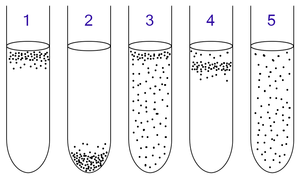微需氧微生物
微需氧微生物(Microaerophile)是一类必须要靠氧气才能生存的微生物。但是,它们能生存环境中的氧气含量低于现在大气中的氧含量(大气中氧含量通常为20%-21%,而这种生物生存环境的氧含量一般为 2-10%)[1][2]。许多微需氧型微生物同样也是需要高浓度二氧化碳(CO2)的嗜二氧化碳生物(比如说属微需氧型的弯曲菌属就生活在二氧化碳浓度为10%的环境中)[3]。

1中培养的是专性需氧微生物。因为它们不能进行发酵及无氧呼吸,所以它们浮在了氧含量最高的上层。
2中培养的是专性厌氧微生物。因为它们体内因无过氧化氢酶等物质无法在有氧条件下存活,故浮在氧含量最低的下层。
3中培养的是兼性厌氧菌。它们既可以在有氧条件下也能够在无氧条件下生存,所以它们分布在试管培养基上的各处。但因为有氧呼吸较无氧呼吸能产生更多的ATP(三磷酸腺苷),故更多的菌体分布在上层。
4中培养的是微需氧微生物。它们不能进行发酵及无氧呼吸,也不能在高氧浓度环境中存活,故它们浮在试管中上层。
5中培养的是耐氧厌氧生物。这种细菌不能进行有氧呼吸,但却可以在高氧浓度环境下存活,所以它们均匀地分布在试管培养基上各处。
培养
编辑微需氧微生物可培养在蜡烛罐中。所谓蜡烛罐是一个密封容器。在关上其密封盖前,要先在里面放上一支点燃的蜡烛。这支燃烧的蜡烛在熄灭前会消耗罐内的氧气,并且生成二氧化碳,从而创造出适合微需氧型微生物生存的高二氧化碳、低氧气环境。[4]创建一个微需氧环境的方法还有使用气体发生包、气体交换。[3]
例子
编辑参见
编辑参考
编辑- ^ Hogg, S. Essential Microbiology 1st. Wiley. 2005: 91–107. ISBN 0-471-49754-1.
- ^ Prescott LM, Harley JP, Klein DA. Microbiology 3rd. Wm. C. Brown Publishers. 1996: 130–131. ISBN 0-697-29390-4.
- ^ 3.0 3.1 3.2 Brooks GF, Carroll KC, Butel JS, Morse SA. Jawetz, Melnick & Adelberg's Medical Microbiology 24th. McGraw Hill. 2007: 273–275. ISBN 0-07-128735-3.
- ^ Salim SM, Mandal J, Parija SC. Isolation of Campylobacter from human stool samples. Indian J Med Microbiol. March 2014, 32 (1): 35–38. PMID 24399385. doi:10.4103/0255-0857.124294.
- ^ Fernie DS, Park RW. The isolation and nature of campylobacters (microaerophilic vibrios) from laboratory and wild rodents. J. Med. Microbiol. August 1977, 10 (3): 325–9. PMID 330861. doi:10.1099/00222615-10-3-325.
- ^ Cover TL. Perspectives on methodology for in vitro culture of Helicobacter pylori. Methods Mol Biol. 2012, 921: 11–15. PMID 23015486. doi:10.1007/978-1-62703-005-2_3.